CQ University MgMT20144 Annotated Bibliography, Semester 2
VerifiedAdded on 2023/06/09
|9
|2598
|60
Annotated Bibliography
AI Summary
This annotated bibliography presents a comprehensive analysis of five peer-reviewed journal articles focusing on key aspects of management and business practices. The articles explore topics such as organizational structure and governance, environmental forces affecting businesses, the functions of diverse firms, risks confronting organizations, and strategies for shaping and strengthening business reputations. Each annotation summarizes the article's core arguments, methodologies, and findings, highlighting the practical implications for business leaders and managers. The bibliography emphasizes the importance of adapting to changing environments, managing risks effectively, fostering diversity, and understanding the impact of external factors on business performance. The conclusion synthesizes the key takeaways from the articles, suggesting that organizations, particularly universities, should proactively manage risks, promote diversity, and maintain transparent communication to ensure long-term success and employee engagement. The references include the DOIs of the articles.
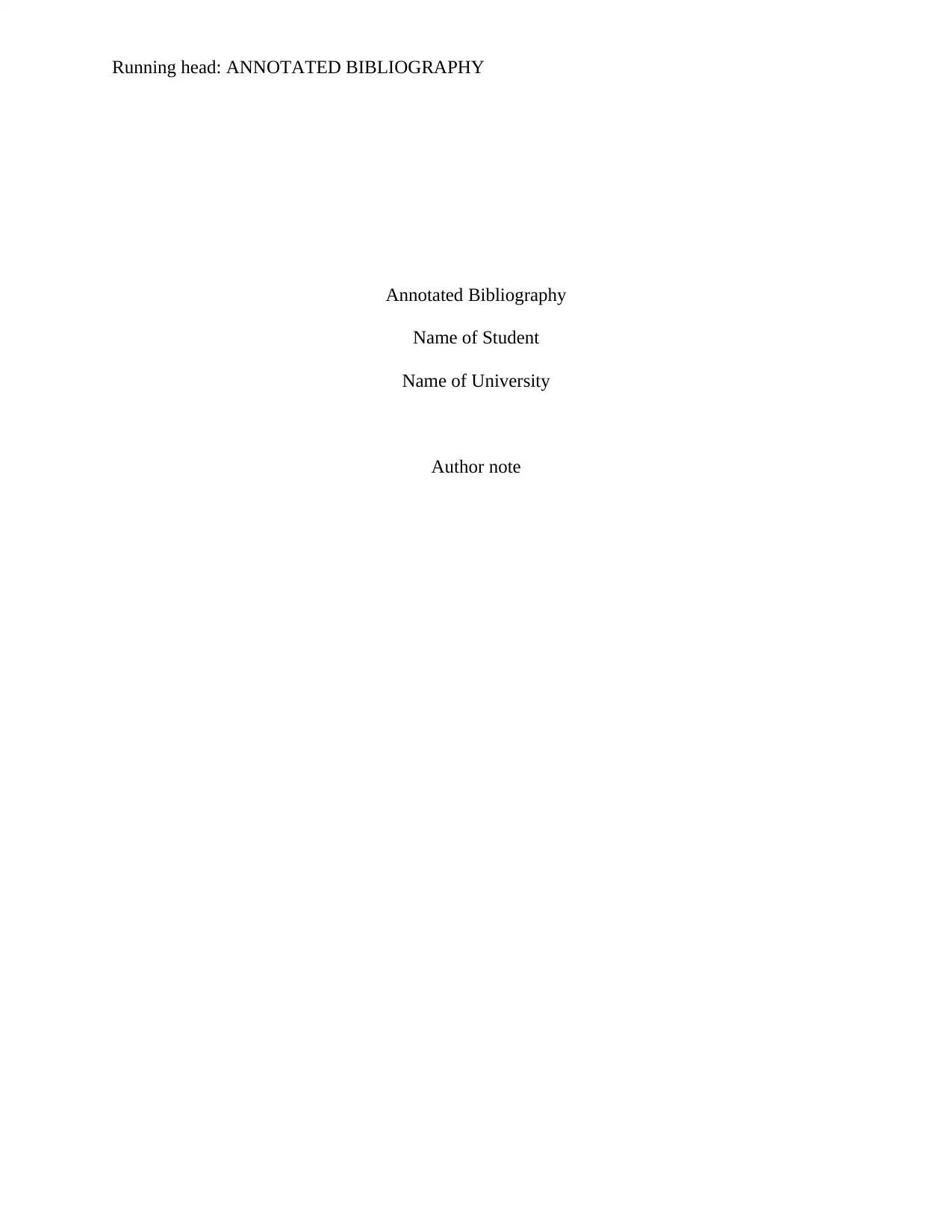
Running head: ANNOTATED BIBLIOGRAPHY
Annotated Bibliography
Name of Student
Name of University
Author note
Annotated Bibliography
Name of Student
Name of University
Author note
Paraphrase This Document
Need a fresh take? Get an instant paraphrase of this document with our AI Paraphraser
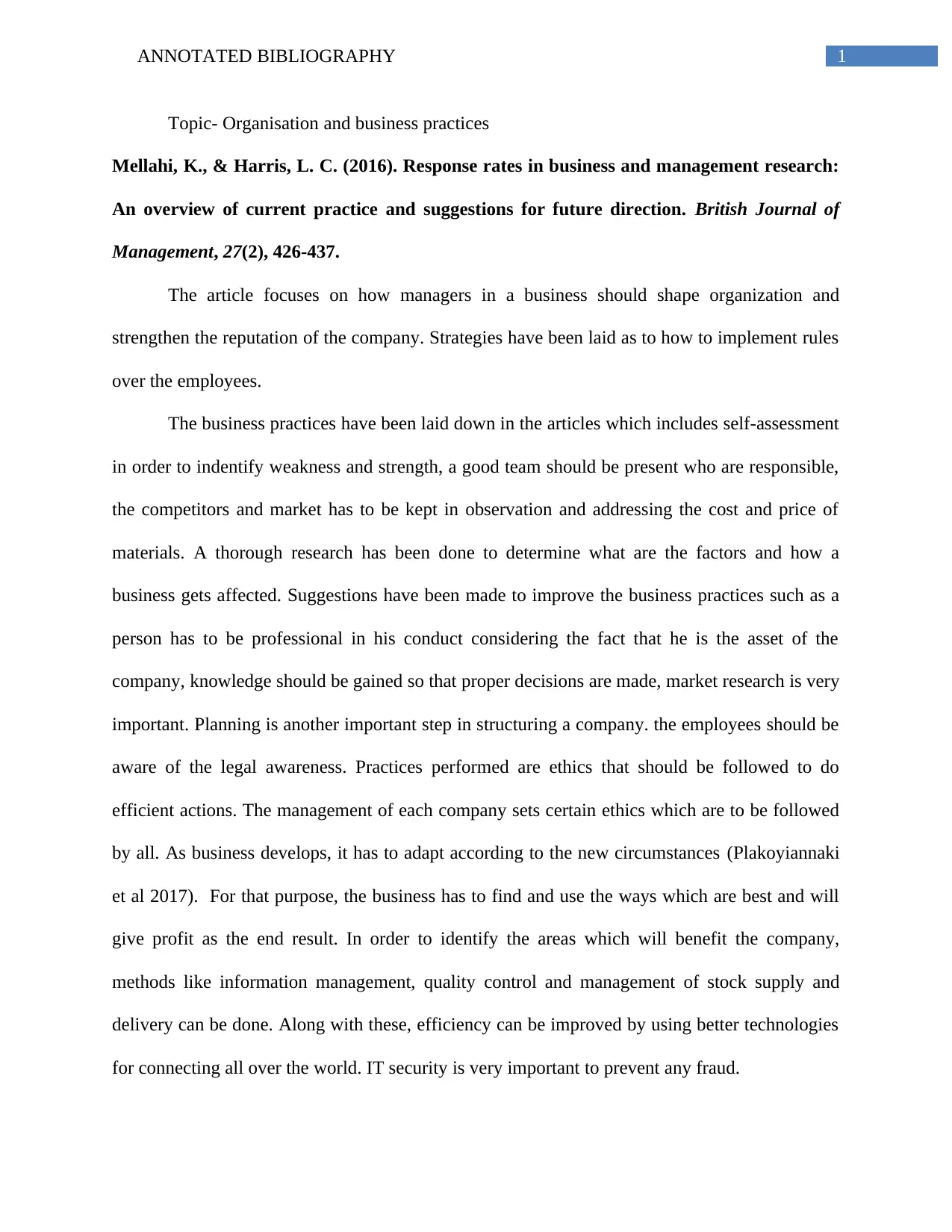
1ANNOTATED BIBLIOGRAPHY
Topic- Organisation and business practices
Mellahi, K., & Harris, L. C. (2016). Response rates in business and management research:
An overview of current practice and suggestions for future direction. British Journal of
Management, 27(2), 426-437.
The article focuses on how managers in a business should shape organization and
strengthen the reputation of the company. Strategies have been laid as to how to implement rules
over the employees.
The business practices have been laid down in the articles which includes self-assessment
in order to indentify weakness and strength, a good team should be present who are responsible,
the competitors and market has to be kept in observation and addressing the cost and price of
materials. A thorough research has been done to determine what are the factors and how a
business gets affected. Suggestions have been made to improve the business practices such as a
person has to be professional in his conduct considering the fact that he is the asset of the
company, knowledge should be gained so that proper decisions are made, market research is very
important. Planning is another important step in structuring a company. the employees should be
aware of the legal awareness. Practices performed are ethics that should be followed to do
efficient actions. The management of each company sets certain ethics which are to be followed
by all. As business develops, it has to adapt according to the new circumstances (Plakoyiannaki
et al 2017). For that purpose, the business has to find and use the ways which are best and will
give profit as the end result. In order to identify the areas which will benefit the company,
methods like information management, quality control and management of stock supply and
delivery can be done. Along with these, efficiency can be improved by using better technologies
for connecting all over the world. IT security is very important to prevent any fraud.
Topic- Organisation and business practices
Mellahi, K., & Harris, L. C. (2016). Response rates in business and management research:
An overview of current practice and suggestions for future direction. British Journal of
Management, 27(2), 426-437.
The article focuses on how managers in a business should shape organization and
strengthen the reputation of the company. Strategies have been laid as to how to implement rules
over the employees.
The business practices have been laid down in the articles which includes self-assessment
in order to indentify weakness and strength, a good team should be present who are responsible,
the competitors and market has to be kept in observation and addressing the cost and price of
materials. A thorough research has been done to determine what are the factors and how a
business gets affected. Suggestions have been made to improve the business practices such as a
person has to be professional in his conduct considering the fact that he is the asset of the
company, knowledge should be gained so that proper decisions are made, market research is very
important. Planning is another important step in structuring a company. the employees should be
aware of the legal awareness. Practices performed are ethics that should be followed to do
efficient actions. The management of each company sets certain ethics which are to be followed
by all. As business develops, it has to adapt according to the new circumstances (Plakoyiannaki
et al 2017). For that purpose, the business has to find and use the ways which are best and will
give profit as the end result. In order to identify the areas which will benefit the company,
methods like information management, quality control and management of stock supply and
delivery can be done. Along with these, efficiency can be improved by using better technologies
for connecting all over the world. IT security is very important to prevent any fraud.
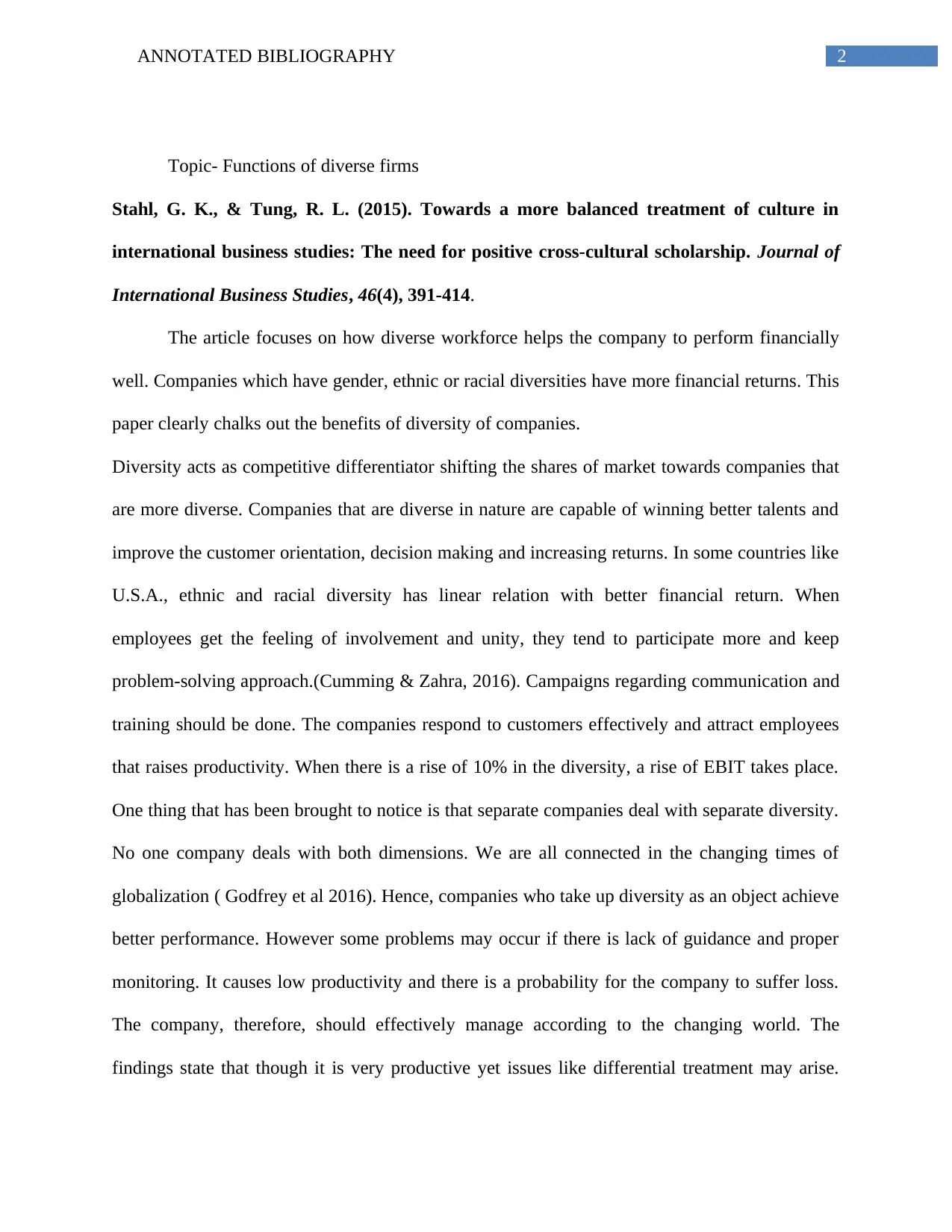
2ANNOTATED BIBLIOGRAPHY
Topic- Functions of diverse firms
Stahl, G. K., & Tung, R. L. (2015). Towards a more balanced treatment of culture in
international business studies: The need for positive cross-cultural scholarship. Journal of
International Business Studies, 46(4), 391-414.
The article focuses on how diverse workforce helps the company to perform financially
well. Companies which have gender, ethnic or racial diversities have more financial returns. This
paper clearly chalks out the benefits of diversity of companies.
Diversity acts as competitive differentiator shifting the shares of market towards companies that
are more diverse. Companies that are diverse in nature are capable of winning better talents and
improve the customer orientation, decision making and increasing returns. In some countries like
U.S.A., ethnic and racial diversity has linear relation with better financial return. When
employees get the feeling of involvement and unity, they tend to participate more and keep
problem-solving approach.(Cumming & Zahra, 2016). Campaigns regarding communication and
training should be done. The companies respond to customers effectively and attract employees
that raises productivity. When there is a rise of 10% in the diversity, a rise of EBIT takes place.
One thing that has been brought to notice is that separate companies deal with separate diversity.
No one company deals with both dimensions. We are all connected in the changing times of
globalization ( Godfrey et al 2016). Hence, companies who take up diversity as an object achieve
better performance. However some problems may occur if there is lack of guidance and proper
monitoring. It causes low productivity and there is a probability for the company to suffer loss.
The company, therefore, should effectively manage according to the changing world. The
findings state that though it is very productive yet issues like differential treatment may arise.
Topic- Functions of diverse firms
Stahl, G. K., & Tung, R. L. (2015). Towards a more balanced treatment of culture in
international business studies: The need for positive cross-cultural scholarship. Journal of
International Business Studies, 46(4), 391-414.
The article focuses on how diverse workforce helps the company to perform financially
well. Companies which have gender, ethnic or racial diversities have more financial returns. This
paper clearly chalks out the benefits of diversity of companies.
Diversity acts as competitive differentiator shifting the shares of market towards companies that
are more diverse. Companies that are diverse in nature are capable of winning better talents and
improve the customer orientation, decision making and increasing returns. In some countries like
U.S.A., ethnic and racial diversity has linear relation with better financial return. When
employees get the feeling of involvement and unity, they tend to participate more and keep
problem-solving approach.(Cumming & Zahra, 2016). Campaigns regarding communication and
training should be done. The companies respond to customers effectively and attract employees
that raises productivity. When there is a rise of 10% in the diversity, a rise of EBIT takes place.
One thing that has been brought to notice is that separate companies deal with separate diversity.
No one company deals with both dimensions. We are all connected in the changing times of
globalization ( Godfrey et al 2016). Hence, companies who take up diversity as an object achieve
better performance. However some problems may occur if there is lack of guidance and proper
monitoring. It causes low productivity and there is a probability for the company to suffer loss.
The company, therefore, should effectively manage according to the changing world. The
findings state that though it is very productive yet issues like differential treatment may arise.
⊘ This is a preview!⊘
Do you want full access?
Subscribe today to unlock all pages.

Trusted by 1+ million students worldwide
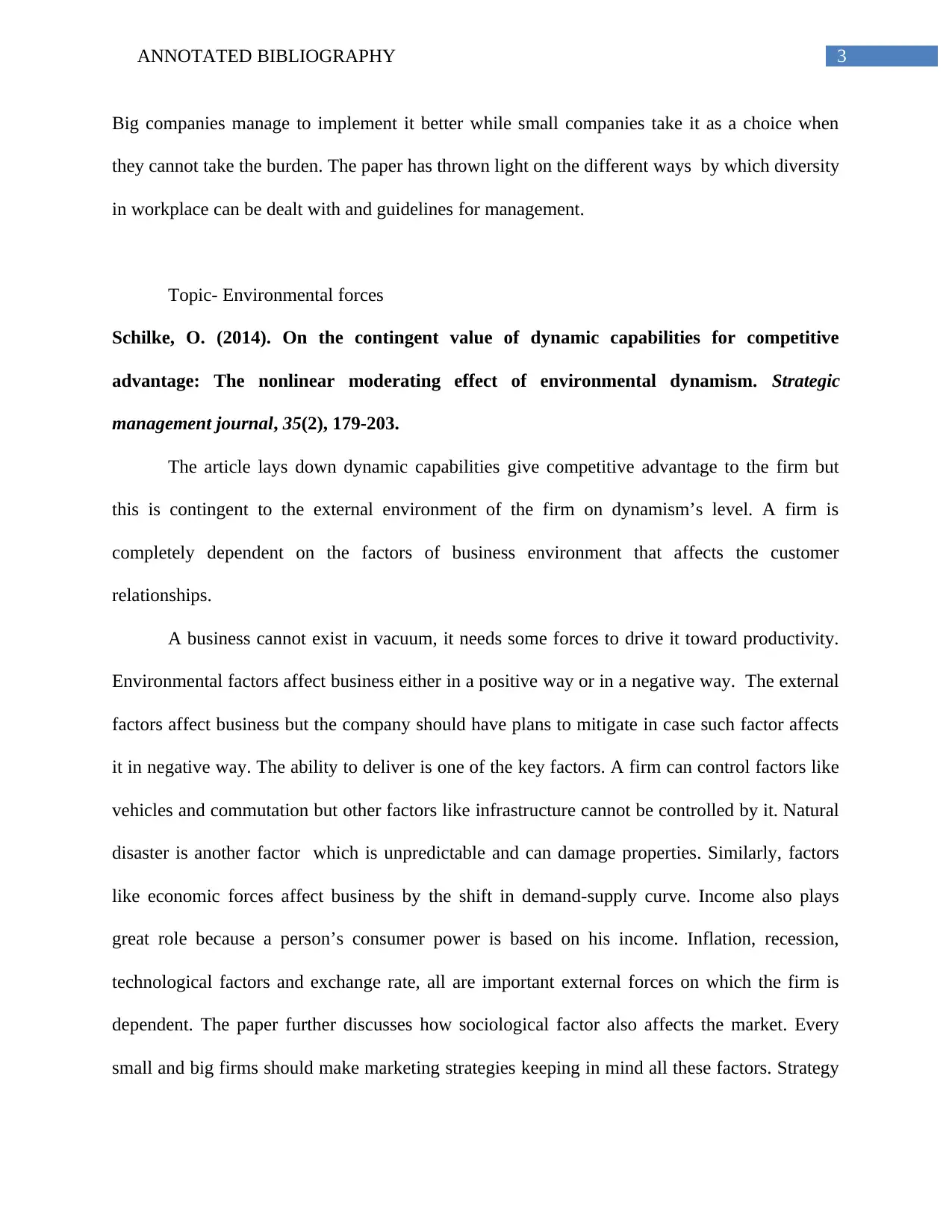
3ANNOTATED BIBLIOGRAPHY
Big companies manage to implement it better while small companies take it as a choice when
they cannot take the burden. The paper has thrown light on the different ways by which diversity
in workplace can be dealt with and guidelines for management.
Topic- Environmental forces
Schilke, O. (2014). On the contingent value of dynamic capabilities for competitive
advantage: The nonlinear moderating effect of environmental dynamism. Strategic
management journal, 35(2), 179-203.
The article lays down dynamic capabilities give competitive advantage to the firm but
this is contingent to the external environment of the firm on dynamism’s level. A firm is
completely dependent on the factors of business environment that affects the customer
relationships.
A business cannot exist in vacuum, it needs some forces to drive it toward productivity.
Environmental factors affect business either in a positive way or in a negative way. The external
factors affect business but the company should have plans to mitigate in case such factor affects
it in negative way. The ability to deliver is one of the key factors. A firm can control factors like
vehicles and commutation but other factors like infrastructure cannot be controlled by it. Natural
disaster is another factor which is unpredictable and can damage properties. Similarly, factors
like economic forces affect business by the shift in demand-supply curve. Income also plays
great role because a person’s consumer power is based on his income. Inflation, recession,
technological factors and exchange rate, all are important external forces on which the firm is
dependent. The paper further discusses how sociological factor also affects the market. Every
small and big firms should make marketing strategies keeping in mind all these factors. Strategy
Big companies manage to implement it better while small companies take it as a choice when
they cannot take the burden. The paper has thrown light on the different ways by which diversity
in workplace can be dealt with and guidelines for management.
Topic- Environmental forces
Schilke, O. (2014). On the contingent value of dynamic capabilities for competitive
advantage: The nonlinear moderating effect of environmental dynamism. Strategic
management journal, 35(2), 179-203.
The article lays down dynamic capabilities give competitive advantage to the firm but
this is contingent to the external environment of the firm on dynamism’s level. A firm is
completely dependent on the factors of business environment that affects the customer
relationships.
A business cannot exist in vacuum, it needs some forces to drive it toward productivity.
Environmental factors affect business either in a positive way or in a negative way. The external
factors affect business but the company should have plans to mitigate in case such factor affects
it in negative way. The ability to deliver is one of the key factors. A firm can control factors like
vehicles and commutation but other factors like infrastructure cannot be controlled by it. Natural
disaster is another factor which is unpredictable and can damage properties. Similarly, factors
like economic forces affect business by the shift in demand-supply curve. Income also plays
great role because a person’s consumer power is based on his income. Inflation, recession,
technological factors and exchange rate, all are important external forces on which the firm is
dependent. The paper further discusses how sociological factor also affects the market. Every
small and big firms should make marketing strategies keeping in mind all these factors. Strategy
Paraphrase This Document
Need a fresh take? Get an instant paraphrase of this document with our AI Paraphraser
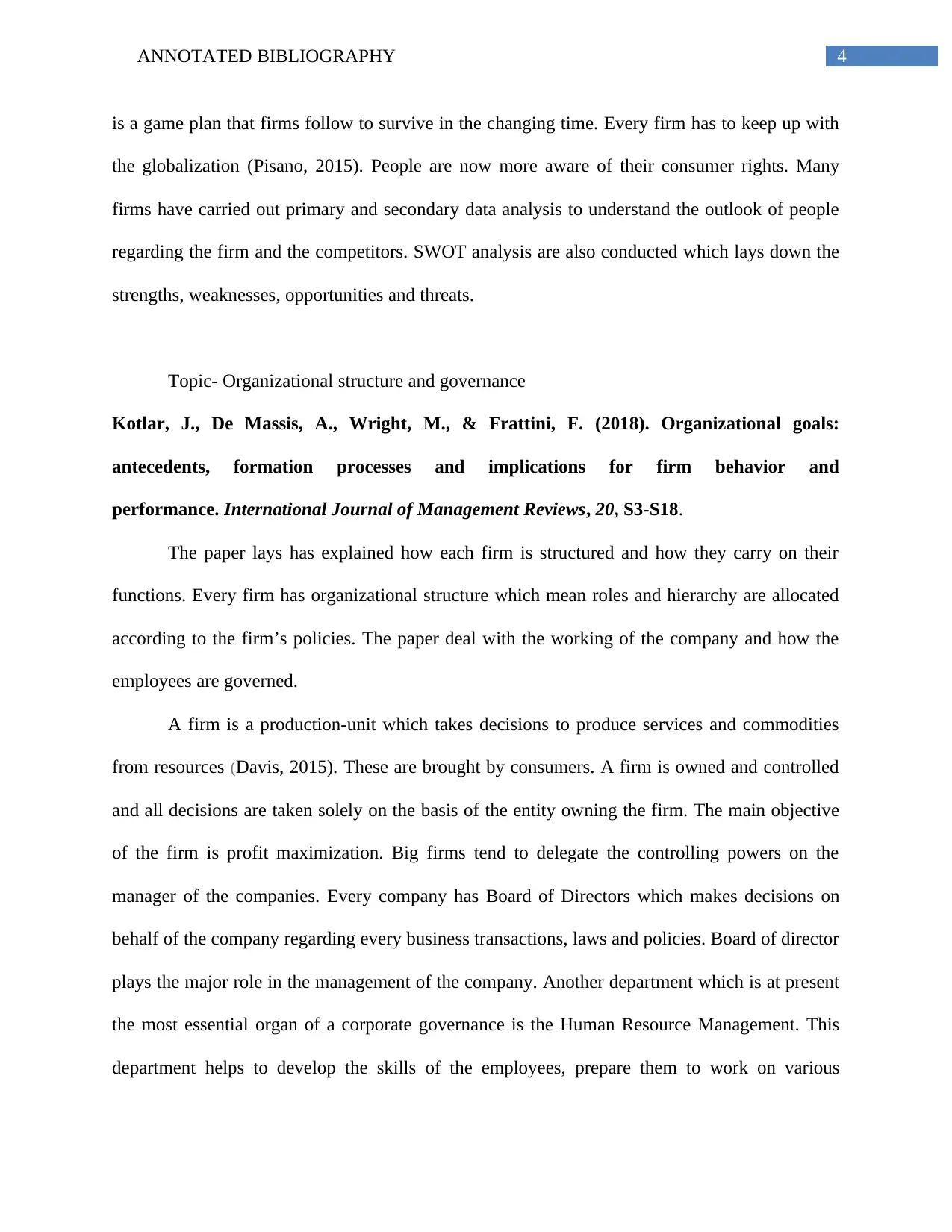
4ANNOTATED BIBLIOGRAPHY
is a game plan that firms follow to survive in the changing time. Every firm has to keep up with
the globalization (Pisano, 2015). People are now more aware of their consumer rights. Many
firms have carried out primary and secondary data analysis to understand the outlook of people
regarding the firm and the competitors. SWOT analysis are also conducted which lays down the
strengths, weaknesses, opportunities and threats.
Topic- Organizational structure and governance
Kotlar, J., De Massis, A., Wright, M., & Frattini, F. (2018). Organizational goals:
antecedents, formation processes and implications for firm behavior and
performance. International Journal of Management Reviews, 20, S3-S18.
The paper lays has explained how each firm is structured and how they carry on their
functions. Every firm has organizational structure which mean roles and hierarchy are allocated
according to the firm’s policies. The paper deal with the working of the company and how the
employees are governed.
A firm is a production-unit which takes decisions to produce services and commodities
from resources (Davis, 2015). These are brought by consumers. A firm is owned and controlled
and all decisions are taken solely on the basis of the entity owning the firm. The main objective
of the firm is profit maximization. Big firms tend to delegate the controlling powers on the
manager of the companies. Every company has Board of Directors which makes decisions on
behalf of the company regarding every business transactions, laws and policies. Board of director
plays the major role in the management of the company. Another department which is at present
the most essential organ of a corporate governance is the Human Resource Management. This
department helps to develop the skills of the employees, prepare them to work on various
is a game plan that firms follow to survive in the changing time. Every firm has to keep up with
the globalization (Pisano, 2015). People are now more aware of their consumer rights. Many
firms have carried out primary and secondary data analysis to understand the outlook of people
regarding the firm and the competitors. SWOT analysis are also conducted which lays down the
strengths, weaknesses, opportunities and threats.
Topic- Organizational structure and governance
Kotlar, J., De Massis, A., Wright, M., & Frattini, F. (2018). Organizational goals:
antecedents, formation processes and implications for firm behavior and
performance. International Journal of Management Reviews, 20, S3-S18.
The paper lays has explained how each firm is structured and how they carry on their
functions. Every firm has organizational structure which mean roles and hierarchy are allocated
according to the firm’s policies. The paper deal with the working of the company and how the
employees are governed.
A firm is a production-unit which takes decisions to produce services and commodities
from resources (Davis, 2015). These are brought by consumers. A firm is owned and controlled
and all decisions are taken solely on the basis of the entity owning the firm. The main objective
of the firm is profit maximization. Big firms tend to delegate the controlling powers on the
manager of the companies. Every company has Board of Directors which makes decisions on
behalf of the company regarding every business transactions, laws and policies. Board of director
plays the major role in the management of the company. Another department which is at present
the most essential organ of a corporate governance is the Human Resource Management. This
department helps to develop the skills of the employees, prepare them to work on various
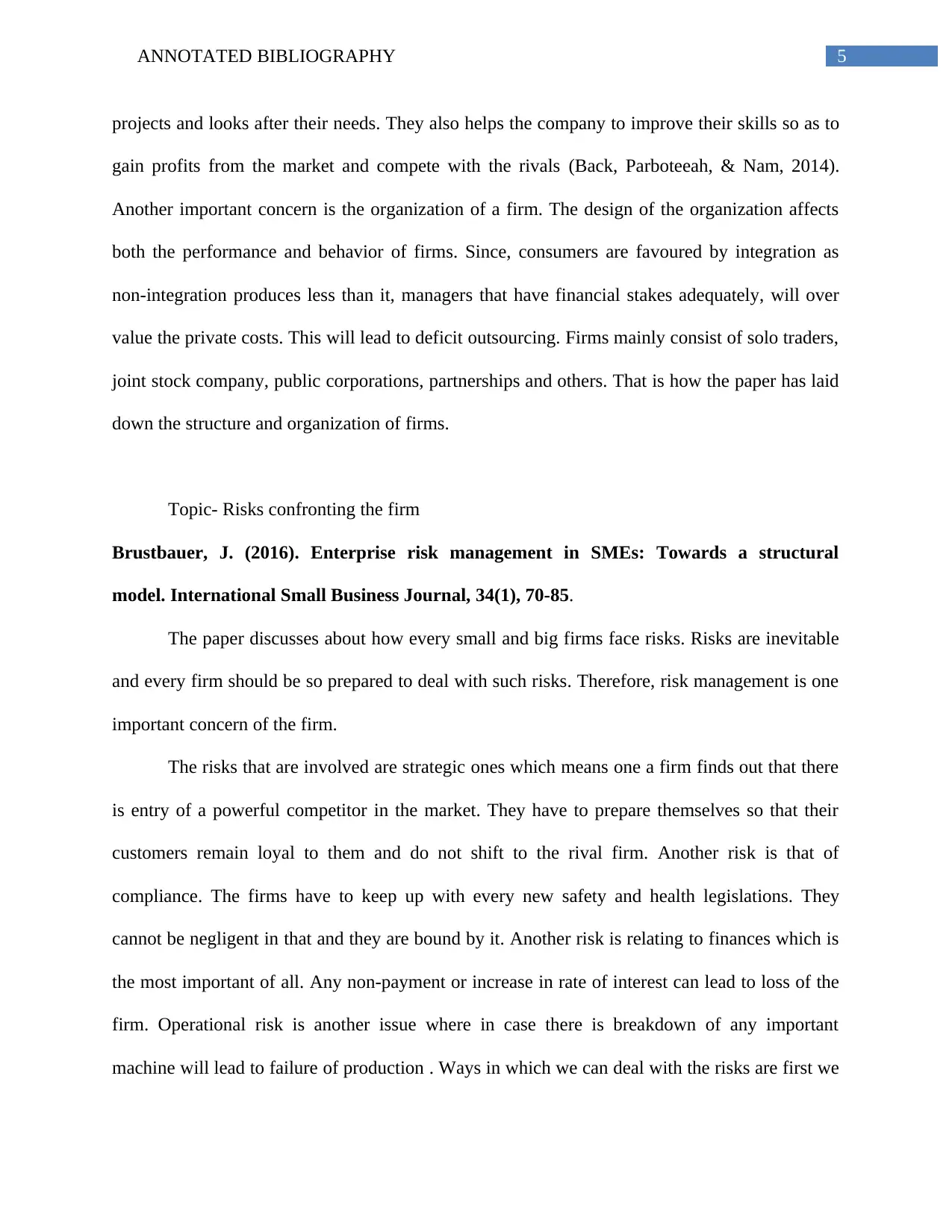
5ANNOTATED BIBLIOGRAPHY
projects and looks after their needs. They also helps the company to improve their skills so as to
gain profits from the market and compete with the rivals (Back, Parboteeah, & Nam, 2014).
Another important concern is the organization of a firm. The design of the organization affects
both the performance and behavior of firms. Since, consumers are favoured by integration as
non-integration produces less than it, managers that have financial stakes adequately, will over
value the private costs. This will lead to deficit outsourcing. Firms mainly consist of solo traders,
joint stock company, public corporations, partnerships and others. That is how the paper has laid
down the structure and organization of firms.
Topic- Risks confronting the firm
Brustbauer, J. (2016). Enterprise risk management in SMEs: Towards a structural
model. International Small Business Journal, 34(1), 70-85.
The paper discusses about how every small and big firms face risks. Risks are inevitable
and every firm should be so prepared to deal with such risks. Therefore, risk management is one
important concern of the firm.
The risks that are involved are strategic ones which means one a firm finds out that there
is entry of a powerful competitor in the market. They have to prepare themselves so that their
customers remain loyal to them and do not shift to the rival firm. Another risk is that of
compliance. The firms have to keep up with every new safety and health legislations. They
cannot be negligent in that and they are bound by it. Another risk is relating to finances which is
the most important of all. Any non-payment or increase in rate of interest can lead to loss of the
firm. Operational risk is another issue where in case there is breakdown of any important
machine will lead to failure of production . Ways in which we can deal with the risks are first we
projects and looks after their needs. They also helps the company to improve their skills so as to
gain profits from the market and compete with the rivals (Back, Parboteeah, & Nam, 2014).
Another important concern is the organization of a firm. The design of the organization affects
both the performance and behavior of firms. Since, consumers are favoured by integration as
non-integration produces less than it, managers that have financial stakes adequately, will over
value the private costs. This will lead to deficit outsourcing. Firms mainly consist of solo traders,
joint stock company, public corporations, partnerships and others. That is how the paper has laid
down the structure and organization of firms.
Topic- Risks confronting the firm
Brustbauer, J. (2016). Enterprise risk management in SMEs: Towards a structural
model. International Small Business Journal, 34(1), 70-85.
The paper discusses about how every small and big firms face risks. Risks are inevitable
and every firm should be so prepared to deal with such risks. Therefore, risk management is one
important concern of the firm.
The risks that are involved are strategic ones which means one a firm finds out that there
is entry of a powerful competitor in the market. They have to prepare themselves so that their
customers remain loyal to them and do not shift to the rival firm. Another risk is that of
compliance. The firms have to keep up with every new safety and health legislations. They
cannot be negligent in that and they are bound by it. Another risk is relating to finances which is
the most important of all. Any non-payment or increase in rate of interest can lead to loss of the
firm. Operational risk is another issue where in case there is breakdown of any important
machine will lead to failure of production . Ways in which we can deal with the risks are first we
⊘ This is a preview!⊘
Do you want full access?
Subscribe today to unlock all pages.

Trusted by 1+ million students worldwide
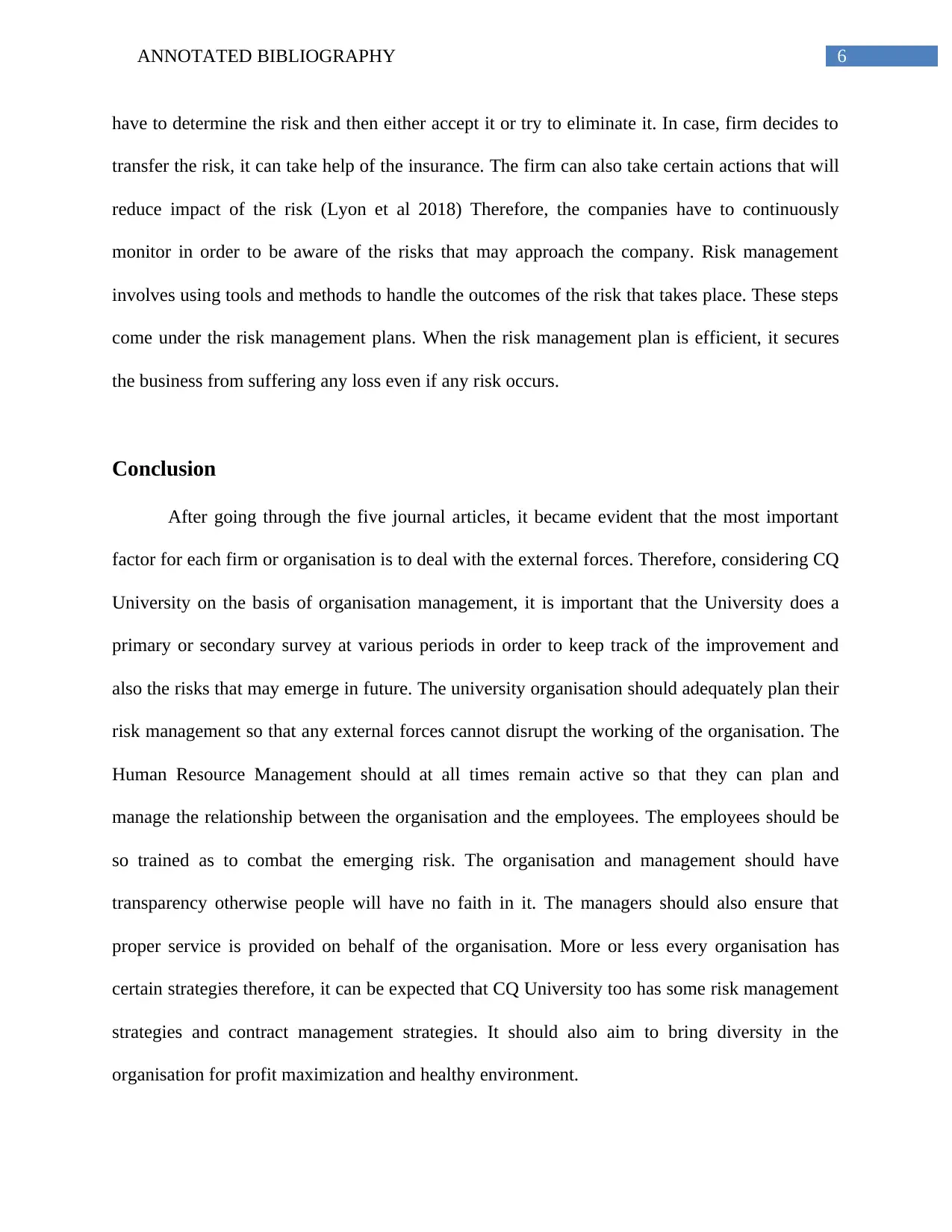
6ANNOTATED BIBLIOGRAPHY
have to determine the risk and then either accept it or try to eliminate it. In case, firm decides to
transfer the risk, it can take help of the insurance. The firm can also take certain actions that will
reduce impact of the risk (Lyon et al 2018) Therefore, the companies have to continuously
monitor in order to be aware of the risks that may approach the company. Risk management
involves using tools and methods to handle the outcomes of the risk that takes place. These steps
come under the risk management plans. When the risk management plan is efficient, it secures
the business from suffering any loss even if any risk occurs.
Conclusion
After going through the five journal articles, it became evident that the most important
factor for each firm or organisation is to deal with the external forces. Therefore, considering CQ
University on the basis of organisation management, it is important that the University does a
primary or secondary survey at various periods in order to keep track of the improvement and
also the risks that may emerge in future. The university organisation should adequately plan their
risk management so that any external forces cannot disrupt the working of the organisation. The
Human Resource Management should at all times remain active so that they can plan and
manage the relationship between the organisation and the employees. The employees should be
so trained as to combat the emerging risk. The organisation and management should have
transparency otherwise people will have no faith in it. The managers should also ensure that
proper service is provided on behalf of the organisation. More or less every organisation has
certain strategies therefore, it can be expected that CQ University too has some risk management
strategies and contract management strategies. It should also aim to bring diversity in the
organisation for profit maximization and healthy environment.
have to determine the risk and then either accept it or try to eliminate it. In case, firm decides to
transfer the risk, it can take help of the insurance. The firm can also take certain actions that will
reduce impact of the risk (Lyon et al 2018) Therefore, the companies have to continuously
monitor in order to be aware of the risks that may approach the company. Risk management
involves using tools and methods to handle the outcomes of the risk that takes place. These steps
come under the risk management plans. When the risk management plan is efficient, it secures
the business from suffering any loss even if any risk occurs.
Conclusion
After going through the five journal articles, it became evident that the most important
factor for each firm or organisation is to deal with the external forces. Therefore, considering CQ
University on the basis of organisation management, it is important that the University does a
primary or secondary survey at various periods in order to keep track of the improvement and
also the risks that may emerge in future. The university organisation should adequately plan their
risk management so that any external forces cannot disrupt the working of the organisation. The
Human Resource Management should at all times remain active so that they can plan and
manage the relationship between the organisation and the employees. The employees should be
so trained as to combat the emerging risk. The organisation and management should have
transparency otherwise people will have no faith in it. The managers should also ensure that
proper service is provided on behalf of the organisation. More or less every organisation has
certain strategies therefore, it can be expected that CQ University too has some risk management
strategies and contract management strategies. It should also aim to bring diversity in the
organisation for profit maximization and healthy environment.
Paraphrase This Document
Need a fresh take? Get an instant paraphrase of this document with our AI Paraphraser
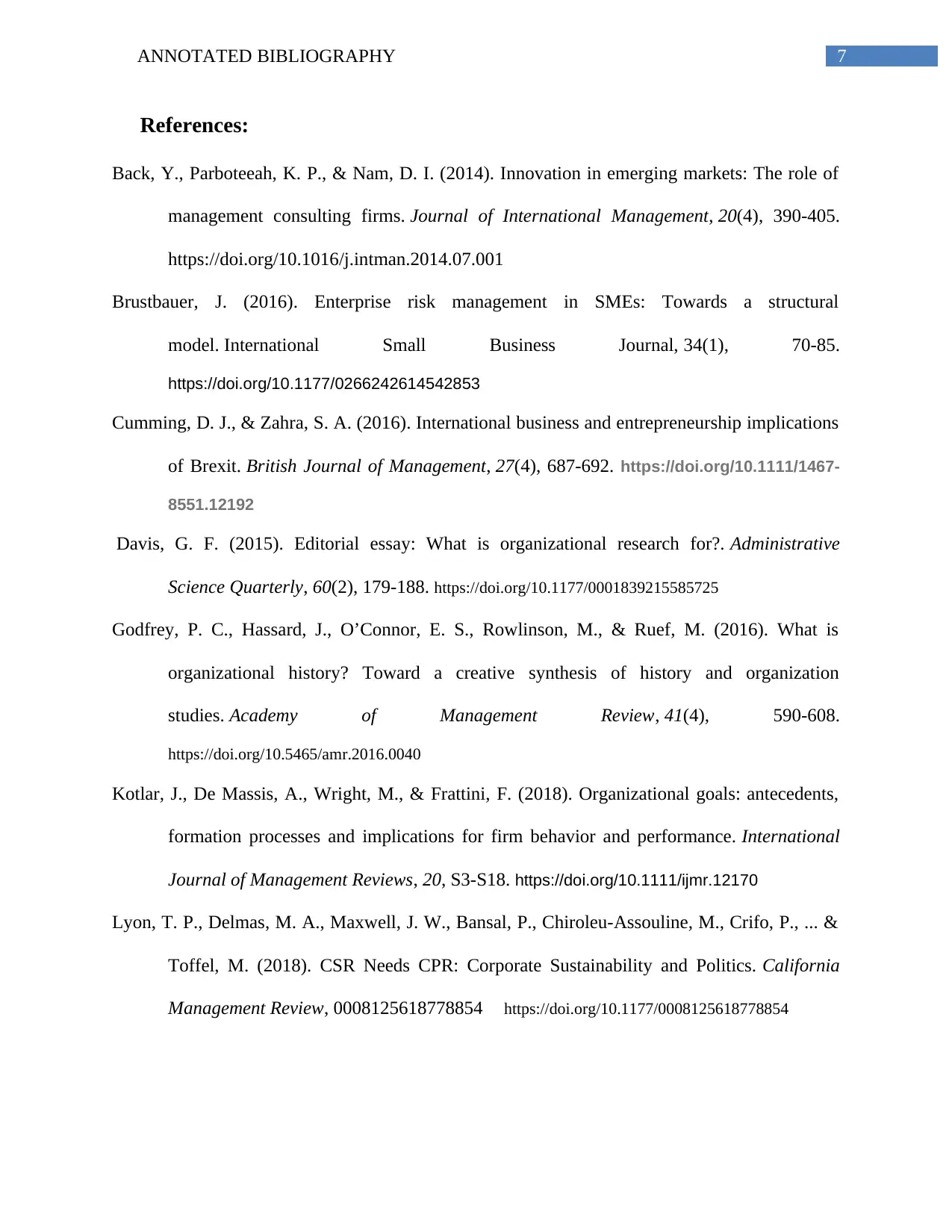
7ANNOTATED BIBLIOGRAPHY
References:
Back, Y., Parboteeah, K. P., & Nam, D. I. (2014). Innovation in emerging markets: The role of
management consulting firms. Journal of International Management, 20(4), 390-405.
https://doi.org/10.1016/j.intman.2014.07.001
Brustbauer, J. (2016). Enterprise risk management in SMEs: Towards a structural
model. International Small Business Journal, 34(1), 70-85.
https://doi.org/10.1177/0266242614542853
Cumming, D. J., & Zahra, S. A. (2016). International business and entrepreneurship implications
of Brexit. British Journal of Management, 27(4), 687-692. https://doi.org/10.1111/1467-
8551.12192
Davis, G. F. (2015). Editorial essay: What is organizational research for?. Administrative
Science Quarterly, 60(2), 179-188. https://doi.org/10.1177/0001839215585725
Godfrey, P. C., Hassard, J., O’Connor, E. S., Rowlinson, M., & Ruef, M. (2016). What is
organizational history? Toward a creative synthesis of history and organization
studies. Academy of Management Review, 41(4), 590-608.
https://doi.org/10.5465/amr.2016.0040
Kotlar, J., De Massis, A., Wright, M., & Frattini, F. (2018). Organizational goals: antecedents,
formation processes and implications for firm behavior and performance. International
Journal of Management Reviews, 20, S3-S18. https://doi.org/10.1111/ijmr.12170
Lyon, T. P., Delmas, M. A., Maxwell, J. W., Bansal, P., Chiroleu-Assouline, M., Crifo, P., ... &
Toffel, M. (2018). CSR Needs CPR: Corporate Sustainability and Politics. California
Management Review, 0008125618778854 https://doi.org/10.1177/0008125618778854
References:
Back, Y., Parboteeah, K. P., & Nam, D. I. (2014). Innovation in emerging markets: The role of
management consulting firms. Journal of International Management, 20(4), 390-405.
https://doi.org/10.1016/j.intman.2014.07.001
Brustbauer, J. (2016). Enterprise risk management in SMEs: Towards a structural
model. International Small Business Journal, 34(1), 70-85.
https://doi.org/10.1177/0266242614542853
Cumming, D. J., & Zahra, S. A. (2016). International business and entrepreneurship implications
of Brexit. British Journal of Management, 27(4), 687-692. https://doi.org/10.1111/1467-
8551.12192
Davis, G. F. (2015). Editorial essay: What is organizational research for?. Administrative
Science Quarterly, 60(2), 179-188. https://doi.org/10.1177/0001839215585725
Godfrey, P. C., Hassard, J., O’Connor, E. S., Rowlinson, M., & Ruef, M. (2016). What is
organizational history? Toward a creative synthesis of history and organization
studies. Academy of Management Review, 41(4), 590-608.
https://doi.org/10.5465/amr.2016.0040
Kotlar, J., De Massis, A., Wright, M., & Frattini, F. (2018). Organizational goals: antecedents,
formation processes and implications for firm behavior and performance. International
Journal of Management Reviews, 20, S3-S18. https://doi.org/10.1111/ijmr.12170
Lyon, T. P., Delmas, M. A., Maxwell, J. W., Bansal, P., Chiroleu-Assouline, M., Crifo, P., ... &
Toffel, M. (2018). CSR Needs CPR: Corporate Sustainability and Politics. California
Management Review, 0008125618778854 https://doi.org/10.1177/0008125618778854
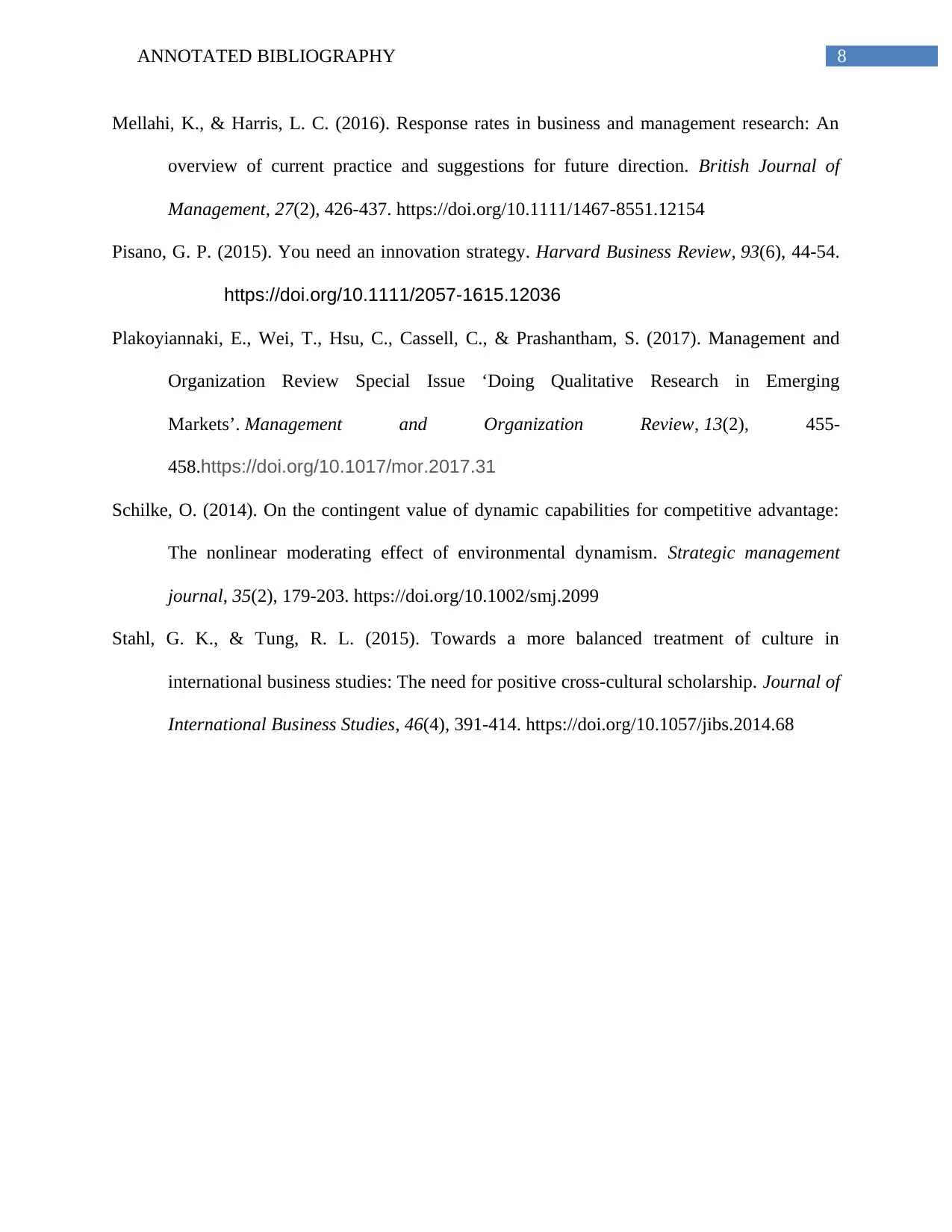
8ANNOTATED BIBLIOGRAPHY
Mellahi, K., & Harris, L. C. (2016). Response rates in business and management research: An
overview of current practice and suggestions for future direction. British Journal of
Management, 27(2), 426-437. https://doi.org/10.1111/1467-8551.12154
Pisano, G. P. (2015). You need an innovation strategy. Harvard Business Review, 93(6), 44-54.
https://doi.org/10.1111/2057-1615.12036
Plakoyiannaki, E., Wei, T., Hsu, C., Cassell, C., & Prashantham, S. (2017). Management and
Organization Review Special Issue ‘Doing Qualitative Research in Emerging
Markets’. Management and Organization Review, 13(2), 455-
458.https://doi.org/10.1017/mor.2017.31
Schilke, O. (2014). On the contingent value of dynamic capabilities for competitive advantage:
The nonlinear moderating effect of environmental dynamism. Strategic management
journal, 35(2), 179-203. https://doi.org/10.1002/smj.2099
Stahl, G. K., & Tung, R. L. (2015). Towards a more balanced treatment of culture in
international business studies: The need for positive cross-cultural scholarship. Journal of
International Business Studies, 46(4), 391-414. https://doi.org/10.1057/jibs.2014.68
Mellahi, K., & Harris, L. C. (2016). Response rates in business and management research: An
overview of current practice and suggestions for future direction. British Journal of
Management, 27(2), 426-437. https://doi.org/10.1111/1467-8551.12154
Pisano, G. P. (2015). You need an innovation strategy. Harvard Business Review, 93(6), 44-54.
https://doi.org/10.1111/2057-1615.12036
Plakoyiannaki, E., Wei, T., Hsu, C., Cassell, C., & Prashantham, S. (2017). Management and
Organization Review Special Issue ‘Doing Qualitative Research in Emerging
Markets’. Management and Organization Review, 13(2), 455-
458.https://doi.org/10.1017/mor.2017.31
Schilke, O. (2014). On the contingent value of dynamic capabilities for competitive advantage:
The nonlinear moderating effect of environmental dynamism. Strategic management
journal, 35(2), 179-203. https://doi.org/10.1002/smj.2099
Stahl, G. K., & Tung, R. L. (2015). Towards a more balanced treatment of culture in
international business studies: The need for positive cross-cultural scholarship. Journal of
International Business Studies, 46(4), 391-414. https://doi.org/10.1057/jibs.2014.68
⊘ This is a preview!⊘
Do you want full access?
Subscribe today to unlock all pages.

Trusted by 1+ million students worldwide
1 out of 9
Related Documents
Your All-in-One AI-Powered Toolkit for Academic Success.
+13062052269
info@desklib.com
Available 24*7 on WhatsApp / Email
![[object Object]](/_next/static/media/star-bottom.7253800d.svg)
Unlock your academic potential
Copyright © 2020–2025 A2Z Services. All Rights Reserved. Developed and managed by ZUCOL.





